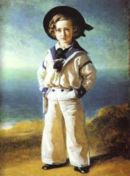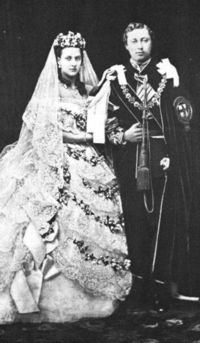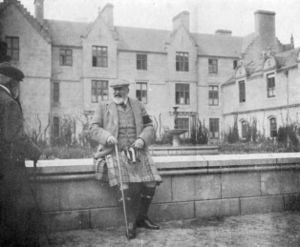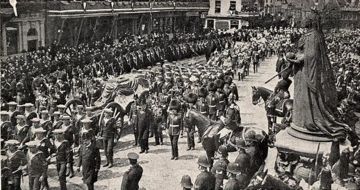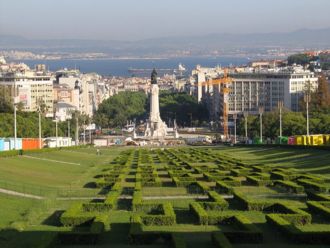Edward VII of the United Kingdom
2007 Schools Wikipedia Selection. Related subjects: British History Post 1900; Monarchs of Great Britain
| Edward VII | |
|---|---|
| King of the United Kingdom, Emperor of India (more...) | |
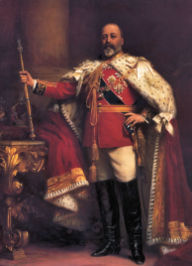 |
|
| King Edward VII after his coronation in 1902 painted by Sir Luke Fildes | |
| Reign | 22 January 1901 - 6 May 1910 |
| Coronation | 9 August 1902 |
| Predecessor | Victoria |
| Successor | George V |
| Consort | Alexandra of Denmark |
| Issue | |
| Albert Victor, Duke of Clarence George V Louise, Princess Royal Princess Victoria Alexandra Maud of Wales Prince Alexander John |
|
| Full name | |
| Albert Edward | |
| Titles | |
| HM The King HRH The Prince of Wales HRH The Duke of Cornwall and Rothesay |
|
| Royal house | House of Saxe-Coburg-Gotha |
| Royal anthem | God Save the King |
| Father | Albert, Prince Consort |
| Mother | Victoria |
| Born | 9 November 1841 Buckingham Palace, London |
| Baptised | 25 January 1842 St George's Chapel, Windsor |
| Died | 6 May 1910 (aged 68) Buckingham Palace, London |
| Burial | 20 May 1910 St George's Chapel, Windsor |
| Occupation | Military |
Edward VII (Albert Edward; 9 November 1841 – 6 May 1910) was King of the United Kingdom of Great Britain and Ireland, King of the Commonwealth Realms, and the Emperor of India. He was the son of Queen Victoria and was the first British monarch of the House of Saxe-Coburg-Gotha. He reigned from 22 January 1901 until his death on 6 May 1910.
Before his accession to the throne, Edward held the title of Prince of Wales, and has the distinction of having been heir apparent to the throne longer than anyone in English or British history, a record being quickly approached by Prince Charles, the current heir apparent. Edward's reign, now called the Edwardian period, saw the first official recognition of the office of the Prime Minister in 1905. He became the first British monarch to visit Russia in 1908, despite refusing to visit in 1906 (as he favoured the Duma over the Tsar). Edward also played a role in the modernization of the British Home Fleet and the reform of the Army Medical Services, after the Second Boer War. His fostering of good relations between Great Britain and other European countries, especially France, for which he was popularly called "Peacemaker", were sadly belied by the outbreak of World War I in 1914.
Early life
Edward was born at 10:48am on 9 November 1841 at Buckingham Palace. His mother was Queen Victoria, the only daughter of Prince Edward Augustus, Duke of Kent and granddaughter of King George III. His father was Prince Albert of Saxe-Coburg-Gotha, first cousin and consort of Victoria. Christened Albert Edward (after his father and maternal grandfather) at St. George's Chapel, Windsor on 25 January 1842, his godparents were the King of Prussia, the Duke of Cambridge, Prince Ferdinand of Saxe-Coburg and Gotha, King Consort of Portugal, the Duchess of Saxe-Coburg and Gotha, the Dowager Duchess of Saxe-Coburg-Altenburg and Princess Sophia. He was known as Bertie throughout his life.
As the eldest son of a British sovereign, he was automatically Duke of Cornwall, Duke of Rothesay, Earl of Carrick, Baron Renfrew, Lord of the Isles and Prince and Great Steward of Scotland at birth. As a son of Prince Albert, he also held the titles of Prince of Saxe-Coburg-Gotha and Duke of Saxony. Queen Victoria created her son Prince of Wales and Earl of Chester on 8 December 1841. He was created Earl of Dublin on 17 January 1850, and a Knight of the Garter on 9 November 1858 and a Knight of the Thistle on 24 May 1867. In 1863, he renounced his succession rights to the Duchy of Saxe-Coburg-Gotha in favour of his younger brother, Prince Alfred.
In 1846, the four-year-old Prince of Wales was given a scaled-down version of the uniform worn by ratings on the Royal Yacht. He wore his miniature sailor suit during a cruise off the Channel Islands that September, delighting his mother and the public alike. Popular engravings, including the famous portrait done by Winterhalter, spread the idea, and by the 1870s, the sailor suit had become normal dress for both boys and girls all over the world.
| British Royalty |
|---|
| House of Saxe-Coburg-Gotha |
 |
| Edward VII |
| Albert, Duke of Clarence |
| George V |
| Louise, Princess Royal |
| Princess Victoria |
| Maud, Queen of Norway |
| Prince Alexander John |
| Maternal grandchildren |
| Alexandra, Duchess of Fife |
| Maud of Fife |
Queen Victoria and Prince Albert determined that their eldest son should have an education that would prepare him to be a model constitutional monarch. At age seven, Bertie embarked upon a rigorous educational program devised by the Prince Consort, and under the supervision of several tutors. However, unlike his elder sister, the Prince of Wales did not excel in his studies. He tried to meet the expectations of his parents, but to no avail. He was not a diligent student and his true talents were those of charm, sociability, and tact. Other observers in his youth found him to be spoiled, lazy, and occasionally cruel.
In October 1859, he matriculated as an undergraduate at Christ Church, Oxford (where he met Lewis Carroll and signed his autograph book but refused to pose for a photograph). Now released from the educational strictures imposed by his parents, he enjoyed studying for the first time and performed satisfactorily in examinations.
The following year he undertook the first tour of North America by a British heir to the throne. His genial good humour and confident bonhomie made the tour a success.
In 1861, his studies were transferred to Trinity College, Cambridge, but he never graduated. The Prince of Wales hoped to pursue a career in the British Army, but this was denied him because he was heir to the throne. He did serve briefly in the Grenadier Guards in 1861; however, this was largely a sinecure. He was advanced from the rank of lieutenant to colonel in a matter of months.
From this time, he gained a reputation as a playboy. In December 1861, his father died from typhoid fever two weeks after visiting Bertie at Cambridge; Prince Albert had reprimanded his son after an actress, Nellie Clifden, had been hidden in his tent by his fellow officers during army manoeuvres in Ireland. The Queen, who was inconsolable and wore mourning for the rest of her life, blamed Bertie for his father's death. She regarded her son as frivolous, indiscreet, and irresponsible. As a joke of the period went, "How is the Queen like the weather? Because she reigns [rains], and reigns, and reigns... and never gives the poor son [Sun] a chance."
Marriage
Once widowed, Queen Victoria effectively withdrew from public life, but shortly after the Prince Consort's death, she arranged for her son to marry Princess Alexandra of Denmark, the beautiful eldest daughter of King Christian IX of Denmark. The couple wed at St. George's Chapel, Windsor on 10 March 1863.
Edward and his wife established Marlborough House as their London residence and Sandringham House in Norfolk as their country retreat. They entertained on a lavish scale. Their marriage was met with disapproval in certain circles because most of Victoria's relations were German, and Denmark was at loggerheads with Germany over the territories of Schleswig and Holstein. Victoria herself was of two minds as to whether it was a suitable match. After the couple's marriage, she expressed anxiety about their lifestyle and attempted to dictate to them on various matters, including the names of their children.
Edward treated his marriage with indifference, keeping mistresses throughout his married life, including actress Lillie Langtry, and socialite Jennie Jerome (mother of Winston Churchill and wife at the time to Lord Randolph Churchill), Daisy Greville, Countess of Warwick, actress Sarah Bernhardt, dancer La Belle Otero, and wealthy humanitarian Agnes Keyser. Lord Charles Beresford began an affair with Daisy Greville, Countess of Warwick, at the same time as Edward VII's, which would cause a strain on the friendship between the two men that would last for the remainder of their lives.
In 1870 Sir Charles Mordaunt threatened to name the Prince as co-respondent in the Mordaunts's divorce, ultimately he did not do so but the Prince was called as a witness. Charles Mordaunt was a Member of Parliament and, during the case, it was shown that the Prince had visited the Mordaunts's house whilst Sir Charles was away sitting in the House of Commons. Although nothing further was proved, and the Prince denied he had committed adultery, the suggestion of impropriety was still damaging.
Agnes Keyser, as recorded by author Raymond Lamont-Brown in his book Edward VII's Last Loves: Alice Keppel and Agnes Keyser, held an emotional bond with Edward VII that others did not, due to her being unmarried herself, and preferring a more private affair to a public one. This trait also made her the favoured in royal circles of his last two loves. He also helped her and her sister fund a hospital for military officers.
His wife, Alexandra, is believed to have been aware of most of his affairs, and to have accepted them. The diary of one of her Ladies-in-Waiting records her looking out of a window overcome with giggles at the sight of Edward and his almost equally large mistress riding side-by-side in an open carriage. He and Lord Randolph Churchill did quarrel for a time during Edward VII's involvement with Churchill's wife ( Jennie Jerome), but eventually mended their friendship, which would then last until Lord Randolph's death. Alexandra was said to have been quite admiring of Jennie Jerome, enjoying her company despite the affair.
His last "official" mistress (although simultaneous to his involvement with Keyser), society beauty Alice Keppel, was even allowed by Alexandra to be present at his deathbed in 1910 at his express written instruction, although Alexandra reportedly did not like her. Keppel also is rumored to have been one of the few people who could help quell Edward VII's unpredictable mood swings. One of Keppel's great granddaughters, Camilla Parker Bowles, was later to become the mistress and then wife of Charles, Prince of Wales, one of Edward's great-great grandsons. It has been suggested that Camilla's grandmother, Sonia Keppel (born in May 1900), was the illegitimate daughter of Edward. However, the King never acknowledged any illegitimate children.
Heir apparent
During Victoria's widowhood, he represented her at public ceremonies and gatherings – opening the Thames Embankment, Mersey Tunnel and Tower Bridge. But even as a husband and father, Bertie was not allowed by his mother to have an active role in the running of the country until 1898. He annoyed his mother by siding with Denmark on the Schleswig-Holstein Question (she was pro-German), and later in the same year annoyed her again by making a special effort to meet Garibaldi.

He enthusiastically indulged in pursuits such as gambling and country sports. Edward was also a patron of the arts and sciences and helped found the Royal College of Music. He laid out a golf course at Windsor, and was an enthusiastic hunter. He ordained that all the clocks at Sandringham be put forward by half an hour in order to create more time for shooting. This so-called tradition of Sandringham Time continued until 1936, when it was abolished by Edward VIII.
In the winter of 1871 he contracted typhoid, the disease that had killed his father, whilst staying at Londesborough Lodge. There was great national concern. One of his fellow guests ( Lord Chesterfield) died, but the Prince managed to pull through. His near brush with death led to an improvement both in his relationship with his mother, as well as in his popularity with the public.
An active Freemason throughout his adult life, Edward VII was installed as Grand Master in 1875, giving great impetus and publicity to the fraternity. He regularly appeared in public, both at home and on his tours abroad, as Grand Master, laying the foundation stones of public buildings, bridges, dockyards, and churches with Masonic ceremony. His presence ensured publicity, and reports of Masonic meetings at all levels appeared regularly in the national and local press. Freemasonry was constantly in the public eye, and Freemasons were known in their local communities. Edward VII was one of the biggest contributors to the fraternity.
In 1890, he was embroiled in the Royal Baccarat Scandal, when it was revealed he had played an illegal card game for money. The Prince was forced to appear as a witness in court for a second time when one of the players sued for slander after being accused of cheating.
On his way to Denmark through Belgium on 4 April 1900 he was the victim of an attempted assassination, when Jean-Baptiste Sipido shot at him in protest at the Boer War.
King
When Queen Victoria died on 22 January 1901, the Prince of Wales became king. Then 59, he was the second oldest man to ascend to the throne in British history (the oldest having been William IV, who ascended at age 64). To the surprise of many, he chose to reign under the name Edward VII instead of Albert Edward, the name his mother had intended for him to use. (No English or British sovereign has ever reigned under a double name.) The new King declared that he chose the name Edward as an honoured name borne by six of his predecessors, and that he did not wish to diminish the status of his father with whom alone among royalty the name Albert should be associated. Some observers, noting also such acts of the new king as lighting cigars in places where Queen Victoria had always prohibited smoking, thought that his rejection of Albert as a reigning name was his acknowledgment that he was finally out from under his parents' shadows. The number VII was occasionally omitted in Scotland, in protest at his use of a name carried by English kings who had "been excluded from Scotland by battle".
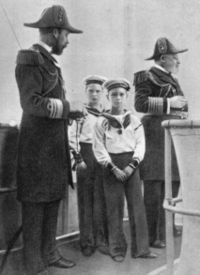
He donated his parents' house, Osborne on the Isle of Wight, to the state and continued to live at Sandringham. He could afford to be magnanimous; it was claimed that he was the first heir to succeed to the throne in credit. 9 (This was due to the tireless efforts of Sir Dighton Probyn, VC Comptroller of the Household, and who stayed with Queen Alexandra's Household after the King's death in the same capacity) Edward VII and Queen Alexandra were crowned at Westminster Abbey on 9 August 1902 by the 80-year-old Archbishop of Canterbury Frederick Temple who died only 4 months later. His coronation had originally been scheduled for 26 June but two days before on 24 June, Edward developed appendicitis. Thanks to the discovery of anaesthesia in the preceding 50 years he was able to undergo a life-saving operation, performed by Sir Frederick Treves. This was at a time when appendicitis was not treated operatively and thus carried with it a mortality rate of greater than 50%. When the Prince objected to missing the coronation to have the surgery, the famous surgeon Sir Joseph Lister told him, "Then, Your Highness, you will be attending it as a corpse". Treves, with Lister's support, performed a then radical operation of draining the infected appendix through a small incision. The next day he was sitting up in bed smoking a cigar. Two weeks later it was announced that the King was out of danger. Treves was subsequently given the baronetcy and appendix surgery entered the medical mainstream for the first time in history.
The Shah of Persia, Mozzafar-al-Din, visited England around 1902 on the promise of receiving the Order of the Garter. King Edward VII refused to give this high honour to the Shah. A quick thinking Secretary had a special medal made that resembled the Order, but was missing the Cross of St. George. He had it sent to the royal yacht just in time for the Shah's arrival. The King was so enraged by the sight of the medal, though, that he threw it out of his yacht's porthole. As a consolation, the Shah was introduced to the King's tailor, Henry Poole and Co. on Savile Row. A few years later, Britain sent the Shah a full Order of the Garter.
As king, Edward's main interests lay in the fields of foreign affairs and naval and military matters. Fluent in French and German, he made a number of visits abroad, and took annual holidays at Biarritz and Marienbad. One of his most important foreign trips was an official visit to France in spring 1903 as the guest of President Émile Loubet. Following on from the first visit of a British or English king to the Pope in Rome, this trip helped create the atmosphere for the Anglo-French Entente Cordiale, an informal agreement delineating British and French colonies in North Africa, and making virtually unthinkable the wars that had so often divided the countries in the past. Negotiated between the French foreign minister, Théophile Delcassé, and the British foreign secretary, the Marquess of Lansdowne, and signed on 8 April 1904 by Lord Lansdowne and the French ambassador Paul Cambon, the Entente marked the end of centuries of Anglo-French rivalry and Britain's splendid isolation from Continental affairs. It also was an attempt to counterbalance the growing dominance of the German Empire and its ally, Austria-Hungary.
"Uncle of Europe"
Edward VII, mainly through his mother and his father-in-law, was related to nearly every other European monarch and came to be known as the "uncle of Europe". The German Emperor Wilhelm II, Tsar Nicholas II of Russia, Grand Duke Ernst Ludwig of Hesse and by the Rhine and Grand Duke Carl Eduard of Saxe-Coburg-Gotha were Edward's nephews; Queen Victoria Eugenia of Spain, Crown Princess Margaret of Sweden, Crown Princess Marie of Romania and Empress Alexandra Feodorovna of Russia were his nieces; King Haakon VII of Norway was his son-in-law and nephew by marriage; King George I of the Hellenes and King Frederick VIII of Denmark were his brothers-in-law; and King Albert I of Belgium, Kings Charles I of Portugal and Manuel II of Portugal, King Ferdinand of Bulgaria, Queen Wilhelmina of the Netherlands, and Prince Ernst August, Duke of Brunswick-Lüneburg, were his cousins. Edward doted on his grandchildren, and indulged them, to the consternation of their governesses. However, there was one relation whom Edward did not like - his volatile relationship with his nephew, Wilhelm II, exacerbated the tensions between Germany and Britain in the decade before World War I.
In the last year of his life, Edward became embroiled in a constitutional crisis when the Conservative majority in the House of Lords refused to pass the " People's Budget" proposed by the Liberal government of Prime Minister Herbert Henry Asquith. The King let Asquith know that he would only be willing to appoint additional peers, if necessary, to enable the budget's passage in the House of Lords, if Asquith won two successive general elections.
Edward was rarely interested in politics, although his views on some issues were notably liberal for the time, e.g. during his reign he said use of the word " nigger" was "disgraceful" despite it then being in common parlance, and he had to be dissuaded from breaking with constitutional precedent by openly voting for Gladstone’s Representation of the People Bill in the House of Lords. On other matters he was less progressive – he did not favour giving votes to women or Irish Home Rule (initially preferring a form of Dual Monarchy), however, his personal charm with people at all levels of society and his strong condemnation of prejudice went some way to assuage republican and racial tensions building during his lifetime.
Death
In March 1910 the King was staying at Biarritz when he collapsed. He remained there to convalesce whilst Asquith remained in London trying to get the Finance Bill passed. The King's continued ill-health was unreported and he came in for some criticism for staying in France whilst political tensions were so high. On 27 April he returned to Buckingham Palace, still suffering from severe bronchitis. The Queen returned from visiting her brother, King George I of Greece, in Corfu a week later on 5 May.
The following day, the King died at 11:45pm. On his deathbed, the Prince of Wales (shortly to be King George V) told him that his horse 'Witch of the Air' had won at Kempton Park to which he replied, "I am very glad", his final words.
As king, Edward VII proved a greater success than anyone had expected, but he was already an old man and had little time left to learn the role. He ensured that his second son and heir, who would become King George V, was better prepared to take the throne. Edward VII is buried at St George's Chapel, Windsor Castle. As Barbara Tuchman noted in The Guns of August, his funeral marked "the greatest assemblage of royalty and rank ever gathered in one place and, of its kind, the last."
Titles, styles, honours and arms
Titles
- 1841: His Royal Highness The Duke of Cornwall
- 1841- 1901: His Royal Highness The Prince of Wales
- in Scotland: 1841- 1901: His Royal Highness The Prince Albert, Duke of Rothesay
- 1901- 1910: His Majesty The King
and, occasionally, outside of the United Kingdom, and with regard to India
- 1901- 1910: His Imperial Majesty The King-Emperor
Issue
| Name | Birth | Death | Notes |
|---|---|---|---|
| HRH Prince Albert Victor, Duke of Clarence and Avondale | 8 January 1864 | 14 January 1892 | |
| HM King George V | 3 June 1865 | 20 January 1936 | married 1893, Princess Mary of Teck; had issue |
| HRH The Princess Louise, Princess Royal | 20 February 1867 | 4 January 1931 | married 1889, Alexander Duff, 1st Duke of Fife; had issue |
| HRH The Princess Victoria | 6 July 1868 | 3 December 1935 | |
| HRH Princess Maud | 26 November 1869 | 20 November 1938 | married 1896, Haakon VII, King of Norway; had issue |
| HRH Prince Alexander John | 6 April 1871 | 7 April 1871 |
Ancestors
| Edward VII of the United Kingdom (09.11.1841–06.05.1910) |
Father: Albert, Prince Consort (26.08.1819–14.12.1861) |
Paternal grandfather: Ernst I, Duke of Saxe-Coburg and Gotha (01.02.1784–29.01.1844) |
Paternal great-grandfather: Francis Frederick of Saxe-Coburg-Saalfeld (15.07.1750–10.12.1806) |
| Paternal great-grandmother: Augusta of Reuss-Ebersdorf (19.01.1757–16.11.1831) |
|||
| Paternal grandmother: Louise of Saxe-Gotha-Altenburg (21.12.1800–30.08.1831) |
Paternal great-grandfather: Emil, Duke of Saxe-Gotha-Altenburg (23.11.1772–27.05.1822) |
||
| Paternal great-grandmother: Louise Charlotte of Mecklenburg-Schwerin (19.11.1779–04.01.1801) |
|||
| Mother: Victoria of the United Kingdom (24.05.1819–22.01.1901) |
Maternal grandfather: Edward Augustus, Duke of Kent and Strathearn (20.11.1767–23.01.1820) |
Maternal great-grandfather: George III of the United Kingdom (04.06.1738–29.01.1820) |
|
| Maternal great-grandmother: Charlotte of Mecklenburg-Strelitz (19.05.1844–17.11.1818) |
|||
| Maternal grandmother: Victoria of Saxe-Coburg-Saalfeld (17.08.1786–16.03.1861) |
Maternal great-grandfather: Francis Frederick of Saxe-Coburg-Saalfeld (15.07.1750–10.12.1806) |
||
| Maternal great-grandmother: Augusta of Reuss-Ebersdorf (19.01.1757–16.11.1831) |
Legacy
Gave his name to the Edwardian Age, 1901-1910.
The lead ship of a new class of battleships, launched in 1903, was named in his honour, as were four line regiments of the British Army — The Prince of Wales's (North Staffordshire Regiment), The Prince of Wales's Leinster Regiment (Royal Canadians), The Prince of Wales's Own (West Yorkshire Regiment), and The Duke of Cornwall's Light Infantry — and three yeomanry regiments — King Edward's Horse, The Prince of Wales's Own Royal Regiment of Wiltshire Yeomanry Cavalry and the Ayrshire Yeomanry Cavalry (Earl of Carrick's Own). Only one of these titles is currently retained in the Army, by The Staffordshire Regiment (The Prince of Wales's).
King Edward VII seems to be a popular name for schools in England. Two of the largest are King Edward VII Upper School, Melton Mowbray, Leicestershire, founded in 1908, and King Edward VII School in Sheffield, founded in 1905 (formerly Wesley College).
A statue of King Edward VII and supporters constructed from local granite stands at the junction of Union Gardens and Union Street, in the city centre of Aberdeen.
An equestrian statue of him, originally from Delhi, now stands in Queen's Park, Toronto.
King Edward Memorial (KEM) Hospital is amongst the foremost teaching and medical care providing institutions in India. The hospital was founded in Bombay in 1926 as a memorial to the King, who had visited India as Prince of Wales in 1876.
King Edward Memorial Hospital for Women in Subiaco, Western Australia, is the largest maternity hospital in the Perth metropolitan area. Two other Perth landmarks are named in his honour, Kings Park and His Majesty's Theatre, the latter a rare example of an Edwardian Theatre.
The only medical school in the former British colony of Singapore was renamed the King Edward VII College of Medicine in 1921. Originally named the Straits and Federated Malay States Government Medical School, its new name remained until the University of Malaya was founded in the city-state in 1949, whereupon the College became its Faculty of Medicine. The students' hostel adjoining the College of Medicine building retained King Edward's name. The hostel has kept the name since moving to the new Kent Ridge campus of the now- Yong Loo Lin School of Medicine, and is affectionately referred to as the "K.E.7 Hall" by students.
The Parque Eduardo VII in Lisbon is named after him.
King Edward Avenue, a major thoroughfare in Vancouver, is named for him.
The King Edward Cigars are named after him.
The tradition of men not buttoning the bottom button of suit-coats is said to be linked to King Edward VII, who left his undone due to his large girth.
Portrayals
Edward's life was dramatised in the 1975 British television series Edward the Seventh, also known as Edward the King or The Royal Victorians, and starring Charles Sturridge as the adolescent Edward, Timothy West as the adult Edward and Annette Crosbie as Queen Victoria.
Edward was also portrayed in The Duchess of Duke Street, where he had a love affair with Louisa Trotter that only ended when Edward became King. The series was actually based on the story of Rosa Lewis, an Edwardian society cook who had risen from the ranks of a scullery maid to own the famous Cavendish Hotel. However, there is no evidence that Edward VII had an affair with Rosa.
He is also portrayed in the 2003 BBC miniseries, The Lost Prince.
Trivia
- King Edward VII made wearing tweed, Homburg hats and Norfolk jackets fashionable.
- He popularised the wearing of black ties with dinner jackets, instead of white tie and tails.
- He pioneered the pressing of trouser legs from side to side in preference to the now normal front and back creases.
- A friend who, when drunk, addressed him with his common nick-name of "Tum-tum" never appeared in Royal circles again.
- A member of his circle who appeared at Royal Ascot races in a Norfolk jacket was asked by Edward if he was "goin' ratting".
- In Howard Spring's novel I met a lady, the true paternity of a famous actress is questioned, and a newspaper article raises the speculation that Edward VII was her father. The journalist later apologises: "The late King had so many affairs, it was natural to connect him to any unexplained bastard".
- While seeing a preformance of the George Bernard Shaw play John Bull's Other Island he laughed so hard he broke his chair.
- When he succeeded to the Throne he went round the palaces smashing busts of the hated John Brown, ghillie and confidant of his Late Mother, Queen Victoria
